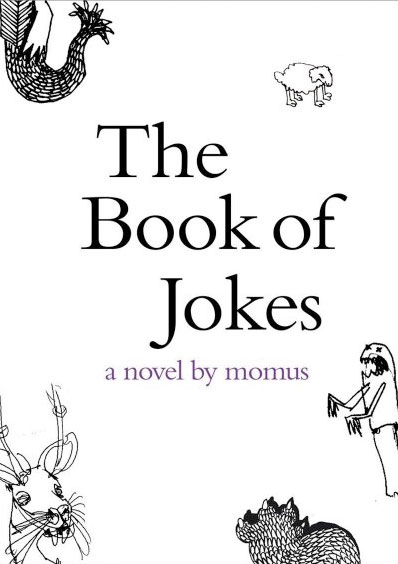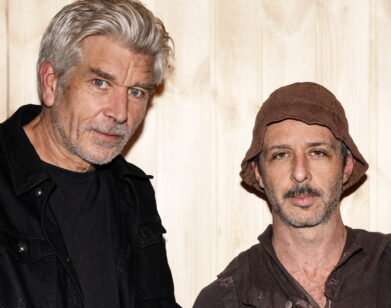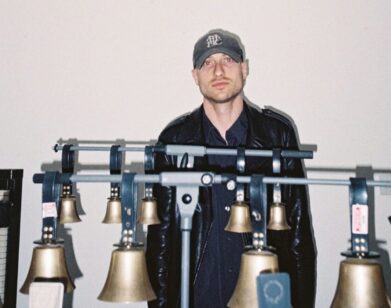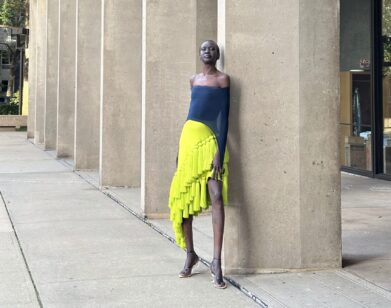It’s Momus’ World

Momus wants us to imagine worlds different from our own. The Scottish artist, musician, and writer speculates on alternative realities that are flagrantly absurd yet grounded in an encyclopedic understanding of culture that only the most edifying bookworms could muscle: When I met him he wore a pink fuzzy eye patch but spoke with the breadth and calmness of a professor-type. In 2006, Momus played the role of the “unreliable tour guide” at the Whitney Biennial, parading around the exhibition with a bullhorn, telling viewers that a photograph of, say, Madonna, was actually a Mayan artifact. As a musician, Momus’ career comprises over twenty albums, ranging in genre from post-punk to folk ballads and even electronic-pop. But it’s with his hyper-literate lyrics that he builds castles in the air. In the 1991 song, “Michelin Man,” he suggested a parallel life for the Michelin mascot as a blow-up doll. In the 1998 track, “Walter Carlos,” he imagined transsexual female musician Wendy Carlos traveling back in time to marry pre-surgery Walter Carlos. Both Michelin and Carlos later threatened to sue. And now, after a years-long output of speculative ideas and observations through his blog, Click Opera, Momus is set to release not one, but two books, both expanding his unique form of satirical thinking and penchant for good taste and bad. The Book of Scotlands, coming out in late July through Sternberg Press, is a random sequence of 156 possibilities for what the country could be. Some of the possibilities are epithet-length sentences and conjectures, while others are longer theatrical dialogues or narratives where fictional characters develop alongside the fictional Scotlands. The Book of Jokes, his first novel due out in September through Dalkey Archive Press, presents the story of a family forced to live out its existence through jokes.
Interview sat down with Momus to discuss his two new titles, and everything else from reverse Orientalism to recession-design and cartoons.
MATTHEW EVANS: The quotation on the front of your new book reads, “Every lie creates a parallel world, the world in which it is true.” You like alternatives.
MOMUS: Well, Picasso said, “Art is the lie that tells the truth,” and it’s not a terribly radical statement. It’s always been that you can tell truth through fiction. And this idea also comes from nuclear physics.
ME: In what sense?
M: Well, in the sense that for every reality there are many parallel, co-existing states.
ME: Because the physical world that we’re accustomed to is not at all the physical reality discovered in the realm of physics?
M: Quantum physics says that there is an infinite number of possibilities and parallels to the one that we know, and every event is also played out in a parallel world. It’s kind of a crazy idea, but someone called Saibal Mitra at the University of Amsterdam says that if you could back up your memory in case of a catastrophic event, you could actually revert to that back-up and find an alternative world in which the Earth didn’t explode or collide with Mars. In The Book of Scotlands, I present a series of parallel Scotlands that aren’t tied to the theories of quantum physics, but instead to the idea of delirious speculation. And if you look at the steps being taken towards Scottish independence right now, they’re being dealt with politically in very dull and boring ways. So if you just feverishly speculate numbered but random Scotlands—because in the book, it’s a random sequence of possibilities—you can imagine many ways in which different things might happen.
ME: So part of the book’s purpose is to reveal the current efforts towards Scottish independence?
M: That’s the general context, although I don’t really talk about it specifically. I’m more interested in the possibilities that could arise from that context, the crazy peripheral and unlikely scenarios.
ME: But some of the content seems to be about places other than Scotland.
M: They might be about Japan. They might be about a company working in a Third-World situation bringing a manual to its employees, saying, “Don’t trust the Scots, they might be terrorists. They might be trying to infiltrate our company.”
ME: It reminds me of the Instructions for American Servicemen series that were passed out during WWII to culturally prepare soldiers for France, Britain, or Japan.
M: Those types of manuals continued in Japan after the War, only they concentrated on how to do business instead of warfare. And each one presents a conflicting picture of Japanese etiquette, a conflicting idea of what Japan is.
ME: The practical side of Orientalism.
M: Sure. But Japan has been a particular victim and benefactor of that process. I write a lot about Japan, but I tend to focus on the glamour, which may come from a more tourists’-eye view, or outsiders’-eye view, but in a positive sense, which is expressed perfectly by glamour.
ME: What do you mean by glamour?
M: I’m ultimately pessimistic, but superficially star-struck. Kafka once said that happiness consists in having an ideal and not progressing towards it. If you did progress towards it, you’d be unhappy because you’d never be able to reach it. You can incrementally improve your life, but you never quite experience the glamour. You never quite get to your utopia, or whatever it is. And once you realize that you can be quite Buddhist about it, and say, “Well, okay, I’m just going to keep detached from it all.” But you can still be star-struck.
ME: In one of your parallel Scotlands you propose this notion of editing:
The Scotland in which Scotland “is an alternative editing table for reality, and its major political task consists of showing how precarious our so-called ‘natural’ context is.”
M: That’s actually a quotation from Nicolas Bourriaud, who defines art as an alternative editing table for reality, which I think is a beautiful idea.
ME: As a musician, what do you think of Bourriaud’s book Post-Production, where he uses the metaphor of the DJ to explain contemporary art? The cross-fading, mixing, editing…
M: DJ Spooky has been pushing that idea for some time, and I find it a bit less persuasive because I’m bored with DJs. Anybody that puts the title DJ in front of their name immediately turns me off. I prefer the term “sampling,” because it has both the dilettante side, like someone tasting wine or caviar, but also functions as a kind of litmus paper dipped into culture. And the whole semi-legality of sampling is very interesting as well. So a DJ is not really creative enough for me to be an appropriate metaphor.
ME: But the idea of cultural hybridity is important to you?
M: Yeah. For me, Calvino’s Invisible Cities, which is a kind of mad collection of observations about cities across the world, is very influential.
ME: That’s interesting, because like Invisible Cities, your book generates a kind of parallel architecture of Scotland through design tutorials of these possible Scottish cities, whether it’s using Le Corbusier’s system of proportion called the Modular, or even Citroën car design.
M: Again, that’s not a terribly new form. Vito Acconci did a thing called the Bristol Project in 2001 where he rambles on, building futuristic parallels and cities with words. Rem Koolhaas has also done this for quite some time; Delirious New York is a prime example. And then he builds it. He starts with the delirium then ends up building these cities like Dubai and Beijing around that delirium.
ME: You’re also a design journalist, and in terms of non-fiction, creating a lie is pretty blasphemous.
M: Journalists do it, too, but they’re not supposed to admit it.
ME: Do you feel that writing about design is conducive to creating alternative, fictive worlds? Design as a medium for projecting dreams?
M: Design is interesting because it’s utopian. Art is often a jaundiced commentary on contemporary life. Design is always about the future; it’s always about something great and new that’s come out that will make the future brighter. It has this weird 18th-century positivism about it.
ME: How do you feel about that kind of fantasy-driven creativity in the practical world of building spaces?
M: I enjoy the optimism of it, even though we can see it as doomed. But I’m telling most people that I’m not writing about design any more this year. It makes no sense at all during the recession unless you write about sustainable or ethical design-very basic things, like how to get clean water in countries with a shortage of it.
ME: Something like Mike Meiré’s Global Street Food project, which looks at improvised kitchens in public places across the world. It not only heightens our sensibility of design, but also our understanding of the social frameworks behind it.
M: That is design that inspires me, because it has the Orientalism and exoticism that we spoke about before; perhaps the glamour. But it also shows us how we can live more cheaply, more effectively, or with less space. It makes us think about and enjoy the high density of those situations that are totally different from our occidental cities. I was just in Jackson Heights in Queens, which has mostly a sub-continental Asian population: Indian, Pakistani; also a lot of Koreans, some Nepalese and Tibetans. Great food, great clothes. Horrible tourism if you like, but then again, that’s the essence of New York for me.
ME: You were the “unreliable tour guide” at the Whitney Biennial in 2006, which led to a collaboration with the design collective Dexter Sinister in the 2008 Biennial as well.
M: In the end I didn’t do anything in the 2008 Whitney Biennial. It was an invitation that never got followed through. But in 2006 I was a semi-official tour guide for three months. And that’s what interested Dexter Sinister in 2008, because they’re fascinated by the status of official documents, especially when they’re a little bit unreliable, or have some weird semi-official status. That’s why they did unofficial press releases for the Biennial. But my thing had been a live, performance version of that; I was walking through the museum making up stuff about the work, which was all lies.
ME: Were people actually convinced?
M: Sometimes. I had a bullhorn, and I was probably quite scary or surprising for a lot of people.
ME: How did people react?
M: First, people were surprised, annoyed, intrigued, they’d be laughing. And then you’d disappear, and they’d say, “What the hell was that?” It turns out that ten years before, Andrea Fraser had done a similar piece in the Whitney Biennial. The curators had no idea, and I didn’t find out until I was actually doing the piece. But she took people into the toilets of the museum and gave tours of the bathrooms as if they were works of art. In those days it was called “institutional critique,” whereas now it’s called “relational aesthetics.”
ME: There’s a sure link between relational aesthetics and your fascination with post-materialism, or things that can’t be owned. And you said recently that the CD is done for as a medium, but performance is still alive and very important for the music experience.
M: Maybe it’s the Calvinist guilt about capitalism or mercantilism. But, I like the idea of doing things that only exist for as long as they exist, which are not archives, which are not sold or prepared even. It’s funny though, because a lot of my unreliable tours were inspired by the docents at the Japan Society, who are mostly these volunteers from the Upper East Side.
ME: Like old ladies who carry their hats in boxes.
M: Yes, they’re very humanist people who want to read uplifting messages into everything. They would be in front of a video of someone masturbating, shouting, “Mother, Mother!” And they would say, “Oh, this is about the human spirit’s capacity to overcome hardship.” They basically find positive messages in really nihilist, perverse videos. So they were my inspiration.
ME: But your work is very sardonic and perverse, which is even more evident in your other book, The Book of Jokes.
M: Yeah, that’s a comic novel based on the idea of a serious telling of jokes. And they’re usually quite filthy, sexual jokes told through the lens of the Bildungsroman.
ME: The coming-of-age novel?
M: Yeah, the classic story-telling device of a twelve-year-old growing up and observing the family around him, and everything’s strange and new and fresh. When you tell filthy jokes as if they were all really serious, and happening all in the life of one family, it becomes a farcical situation. It’s really a book about freedom. Imagine if you had a script that was imposed on your life—we all do in a certain way, from society, or family, the need to make money, biology, death. But you will have a certain latitude, or freedom, to read the script in your own way. It’d just be the adverbs, and not the verbs, that you could change. So the main character has to live his life determined by jokes. He gets to tell the jokes, and can narrate them in different ways. The punch line is like death, you know? So he can walk around avoiding the punch line for as long as possible.
ME: There are restraints with which these characters are operating.
M: They have to live inside jokes. There’s a joke about his grandfather who once crashed a bus: “I want to die peacefully in my sleep like my grandfather, and not screaming in terror like his passengers.”
ME: Do you think that constrained writing can create more possibilities?
M: Yeah, that’s totally true. If you’re a poet and you’re using rhyme, rhyme generates ideas. If you’re a songwriter and you’re using melody and words together, they bounce off each other in interesting ways that you couldn’t get otherwise, because you do things unexpectedly.
ME: And it also goes back to this idea of design restrained by limited resources. If you’re given an unlimited amount of money, complete freedom …
M: … You tend to do things right-whereas I’m really interested in failed design. When you know how to get something right in a way that works, it’s very hard to stop yourself from doing it differently. But there’s something interesting in wrongness. I’m fascinated by the cycle of revivals. I’m interested in taboos, things that are buried or forbidden. A lot of my music career was influenced by the philosopher and writer Georges Bataille, and his idea of transgression-perversity as a virtue.
ME: Isn’t it difficult to look to perversity when it becomes standardized?
M: Well, maybe Paul McCarthy and others have done it in art. Not so much literature, which has become more conservative.
ME: Maybe a way of rediscovering them is through these formal constraints that we talked about earlier.
M: Yeah. The thing about sublimation in the classical Freudian sense is that it makes things stronger if you push them out of your consciousness into some libidinal place. They start growing like mushrooms in the dark. And then, they just burst out with this new energy. It’s like disco music. When it’s just a sub-culture it’s really strong. Then it goes mainstream and gets weak and boring. And then it goes underground again and becomes something else like techno, or house, or whatever. So the idea of transgression will not go away. The thing that would stifle transgression would be that it would become formulaic, like rock’n’roll. The values of rock ‘n’ roll became so mainstream that they couldn’t be transgressive anymore.
ME: How do you feel about pop music? M: It’s kind of easy to be a poet and simply communicate with a thousand people. But pop music was the promise of communicating with a mass audience, at least in the ’80s when I started. The idea of infiltration, entry-ism … that stuff was very tempting.
ME: Didn’t you almost have a hit? M: Yeah, I had an indie hit with a track called “Hairstyle of the Devil” in ’89.
ME: But it wasn’t intended to be a hit.
M: No, it was just played on daytime radio and TV, but I wasn’t terribly interested. I remember something very significant: The engineer’s wife, when I was recording the possible follow-up single to that, said, “Hey, I don’t like your work, but I really respect success. I respect that you’re being played on the radio.” I’d rather be a failure. Malcolm McLaren once said, “It’s better to be an interesting failure than a benign success.” If you can fail across several decades, and keep working, it’s not failure.
ME: But are you still interested in pop?
M: I don’t pay attention to it much anymore.
ME: Is that because you’re in Berlin?
M: Definitely. You can insulate yourself from that culture here. The Anglo-Saxon cultures are drawn to it. Seriously educated people in London will sit around a dinner party talking about Madonna because it’s kind of obligatory. You have different ways of talking about the same culture. So there’s an intelligent way for newspapers like the Guardian to talk about Madonna, and then the tabloids have a stupid way of talking about Madonna. It’s all coded stuff about social class. “Oh, Madonna thinks she’s an aristocrat now.” But I would rather be in Berlin where there’s lots of interesting music being made but it’s never going to cross over. There’s no mainstream here. ME: There’s a lot a flâneurism in The Book of Scotlands.
M: Sure. But flâneurism is more than simply leisure. It’s a way to be serious with an unserious tone, and this is a tone I adopt a lot in The Book of Scotlands.
ME: You also take your cues from the French cartoon series, Les Shadoks, which was also an unserious way of talking about serious things.
M: Well, Les Shadoks is interesting because it’s a cartoon about these little animals that live on Earth, and the moon is coming closer to Earth, threatening catastrophe. But again, it’s told with this narrative voice that is very pseudo-academic. It has this very silly French narrator, and it’s full of these crazy contraptions, and they’re always trying to reach the moon to save the world by building little ladders and machines. But it’s told in a way to make it seem like a grave problem.
ME: Who would you say your reader is for The Book of Scotlands? Or The Book of Jokes?
M: Anybody. It’s very shocking and funny literature. Except for people who are totally grossed out by incest, because there’s a lot of that in The Book of Jokes. Most people would find it funny. But it’s unsettling, and psychologically fucked-up. It’s very Lynchian.
ME: Didn’t David Lynch talk in Berlin a couple years ago with the Raja of Germany about an alternative, invincible Germany?
M: Yeah he did. I didn’t see him speak, but I read the news coverage. You know, I like people who think the unthinkable and say the unsayable in that way, because it is again about lifting the carpet. Whole nations have forbidden topics. Germany especially has a whole closet full of skeletons. And things get power if you keep them closeted. So in a way it’s also healthy to open that closet.
ME: Would you say that The Book of Scotlands is a utopia or a dystopia?
M: It contains little nuggets of both. It’s funny how, in the history of film for instance, utopia and dystopia are so often mixed up. Look at Woody Allen’s Bananas for example. So often people visualize these totalitarian future states where the architecture and the design is beautiful. They always use the best architects and set designers to make this dystopia, and it’s so seductive. Even A Clockwork Orange is seductive. I wrote this piece about how I once found A Clockwork Orange in a video store in Japan in the section “Nice Furniture.” It’s like when Andy Warhol said that he watched movies for the shoe styles. And that’s a kind of liberating thought.
ME: And I think that’s what The Book of Scotlands works towards, taking the obscurities and minor details of your experience of Scotland and other places and imagining them as tokens of a as national identity.
M: It’s like peripheral vision. You can see things out of the corner of your eye that you can’t when you look at them straight on. Rabbits do that, and having a pet rabbit I’m very aware of it. They can see things far away, but they can’t see things directly in front of their faces. So by not looking at Scotland, I’m looking at Scotland. Just by excluding possibilities you make things clearer. It’s a way of looking without looking.






